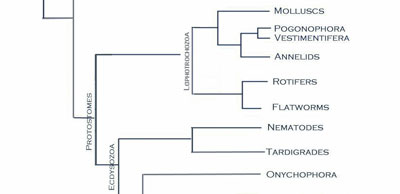Phylogeny
What is phylogeny?
Phylogeny is the study of the origin and evolution of a set of species, including its morphology and behavior. That is, it investigates the evolutionary relatedness of a species to other species.

A section of a phylogenetic tree (a method of tracking phylogeny) including molluscs--which all cephalopods are
Phylogeny of Mimicry in Cephalopods
Mimicry in cephalopods, unlike crypsis, is a recent finding. Crypsis is vastly better-known defensive behavior found in octopuses, cuttlefish and various other cephalopods. Due to this not much is known about the evolutionary scale of the behavior in cephalopods. However, there are some theories that seem prominent.
In the ‘mimic octopus’ and O.cyanea mimicry has evolved as its primary defense mechanism due to its habitat. Due to inconsistency in the availability of prey they have to move long distances while foraging. Thus, they have modified their behavior to be highly conspicuous, but by mimicking a poisonous predator instead of their usual non-toxic selves [1].
In cuttlefish evidence supports that mimicry by the smaller male is used as an alternative mating strategy. This evolves because larger males who usually guard the females obtain about 64% of all matings, thus putting an incredible amount of pressure on the smaller males to develop an alternative strategy [2].
Since both of these cases and most documented cases of mimicry in cephalopods are those of Batesian mimicry, they have common evolutionary characteristics. These characteristics are also shared in mimicry in organisms other than cephalopods.
1. It is largely accepted that Batesian mimicry in general is adaptive due to its positive effects on the reproductive fitness. The mimic gains fitness by convergent evolution.
Many features of mimicry show analogous resemblances, but they are not homologous in terms of development.
2. Mimicry is not inherited by a single gene mutation [3]. There are loci with major effect but the development switch is a “supergene”, which has a number of tightly linked elements. Thus selection has allowed the evolution of mimicry to happen only a little bit at a time.
3. Stable polymorphisms are almost a diagnostic characteristic of Batesian mimicry, especially in organisms that can mimic more than one creature. These polymorphisms can only evolve when the genes involved in the mimicry exist in a tightly linked section, i.e. a supergene [3].